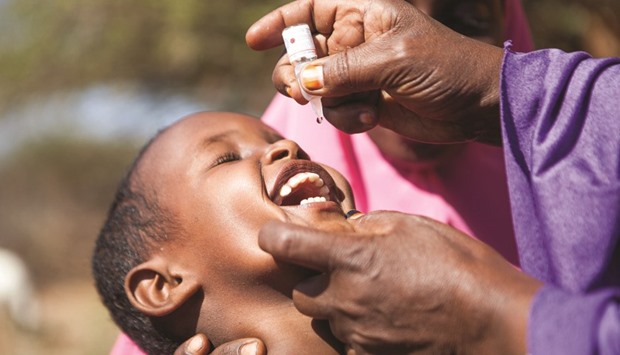
Polio vaccination in Africa.
In February in Addis Ababa, African health ministers signed a widely celebrated declaration of their commitment to keeping immunisation at the forefront of efforts to save the continent’s children from death and disease. Fulfilling that commitment will be no easy feat. Immunisation is not just a health issue; it is also an economic challenge.
The case for vaccination is strong. Globally, an estimated 2-3mn child deaths and 600,000 adult deaths are prevented annually through immunisation. Moreover, immunisation is considered one of the most cost-effective public-health interventions for reducing child morbidity, mortality, and disability. A recent study estimates that every dollar spent on vaccination will save $16 in costs of illnesses averted. Accounting for the value individuals place on longer and healthier lives, net returns on investments in immunisation soar to some 44 times the cost. And net returns exceed costs for all vaccines.
Significant progress has been made. In 2014, 86% of children were immunised against diphtheria, tetanus, and pertussis, compared to less than 5% in 1974. And there have been extraordinary advances in the number and kinds of vaccines that are available.
Yet, worldwide, an estimated 18.7mn infants are not being reached by routine immunisation services. The problem, of course, is access.
Detailed analysis of immunisation in African countries reveals significant disparities within and across countries. More than 60% of the non-immunised infants live in just 10 countries: the Democratic Republic of the Congo (DRC), Ethiopia, India, Indonesia, Iraq, Nigeria, Pakistan, Philippines, Uganda, and South Africa.
Routine immunisation coverage remains particularly low in Africa; indeed, it has stagnated over the last three years, against a backdrop of weak and under-resourced health systems. As a result, one in five African children still do not receive lifesaving vaccination. In 2014, an estimated 42% of all global deaths from measles were in Africa.
Most of Africa’s under-immunised children live in Nigeria, Ethiopia, the DRC, South Sudan, Ethiopia, and Guinea. Poor people, those living in rural areas, and families with lower education levels comprise the majority of those who are not reached.
Clearly, money is a leading factor shaping immunisation outcomes. Beyond inadequately financed health systems, which remain weak and inefficient, especially in rural areas, African countries face challenges in affording new, more expensive vaccines.
New vaccines should be enabling us to save more lives. Yet Médecins Sans Frontières estimates that the introduction of new vaccines made it 68 times more expensive to vaccinate a child in 2014 than in 2001 in most African countries. Another study showed that in 2001, the total cost of the original set of six World Health Organisation-recommended vaccines was less than one dollar. In 2014, the number of WHO-recommended vaccines had risen to 11 – and the cost had reached about $21 for boys and $35 for girls. The added costs of delivery, currently estimated at about $25 per child, bring the total cost of fully immunising a child today to $50-60.
That same study found that, in many low- and middle-income countries, immunisation budgets are currently insufficient to sustain vaccination programmes, much less incorporate the new costlier vaccines. As several health ministers pointed out in Addis Ababa, high vaccine prices force poor countries’ governments to make tough choices about which deadly diseases they can afford to prevent.
For some countries, the situation is about to get worse, as Gavi, the international group which has helped to finance the dramatic global expansion of new vaccines, phases out support for countries deemed to have “graduated” from assistance. Without eligibility for the lower prices obtained by Gavi, many of these countries may not be able to afford newer vaccines.
In order to cope with this challenge, African political leaders have committed to invest in the continent’s capacity to develop and produce its own vaccines. But this is a long-term strategy that will require coordinated regional investment planning, market development, and stronger regulatory capabilities. In the short to medium term, African countries would do well to look into the power of collective bargaining to strike better deals for needed vaccines.
While Africa can and should do more to improve vaccination, the global community also has a responsibility to make a concerted effort to bring down vaccine costs. The recently announced reduction in the price of pneumococcal vaccine is a step in the right direction, but it is not enough. Without collective action, equitable and sustained access to immunisation in Africa will remain a major problem – and children’s lives will continue to be lost. – Project Syndicate
- Folake Olayinka (@joflakes) is a public health specialist and Aspen New Voices Fellow.
